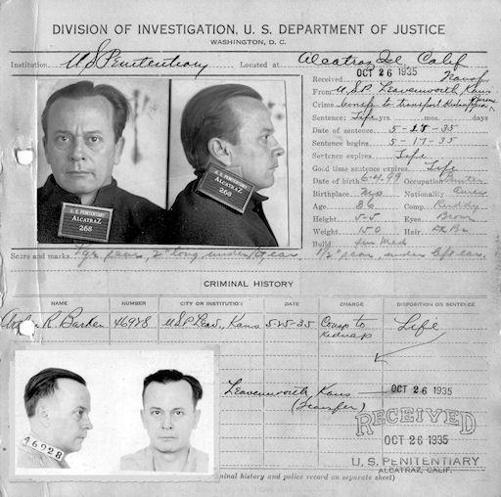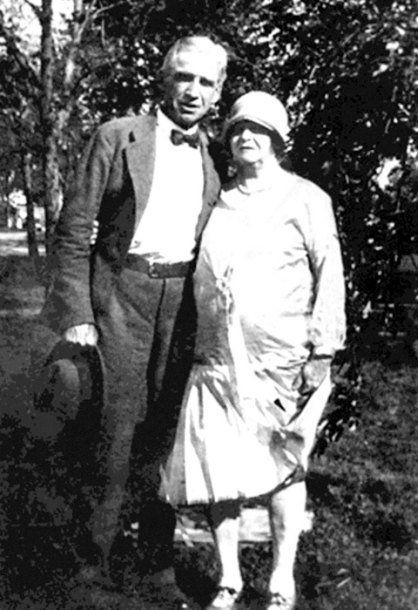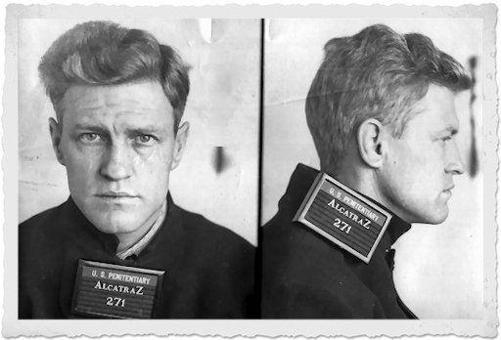Arthur “Doc” Barker

Arthur “Doc” Barker
Doc was a member of the notorious “Ma Barker Gang” that terrorized the Midwest during the early 1930’s. He was born in 1899, into an impoverished family in the remote Ozark Mountains of Missouri. Short in stature, he was the third of four sons who had all been reared into a life of crime by their mother, the legendary Kate Barker, known affectionately by associates simply as “Ma.”

Arthur Dunlop and Kate “Ma” Barker.
The FBI chronicled the family’s history extensively and a confidential report dated November 18, 1936 includes the following description:
Ma Barker in the formative period of her sons' lives was probably just an average mother of a family which had no aspirations or evidenced no desire to maintain any high plane socially. They were poor and existed through no prolific support from Ma's husband, George Barker, who was more or less a shiftless individual... The early religious training of the Barkers... was influenced by evangelistic and sporadic revivals. The parents of the Barkers and the other boys with whom they were associated did not reflect any special interest in educational training and as a result their sons were more or less illiterate... Ma was more intelligent than any of her sons, she ruled them with an iron will and found this expression of dominance easily exerted because of the submission of her sons Fred and Arthur
Hoover further characterized Ma Barker as “a monument to the evils of parental indulgence,” and according to legend, she instructed her boys from an early age in the finer points of robbery, kidnapping, larceny and murder, romanticizing the life and wealth of being an outlaw.
The family eventually moved to Tulsa Oklahoma where the Barker boys quickly became community nuisances, engaging in petty thefts and forming a youth crime group dubbed the “Central Park Gang.” During his adolescence Doc would form strongly bonded relationships with these town hoodlums, including Volney Davis and Harry Campbell, who years later would also find their way to Alcatraz. Another gang associate, William Green, would conspire in a 1931 mass escape from Leavenworth Prison, and would ultimately commit suicide to avoid recapture.

Volney Davis
The eldest Barker son, Herman, was arrested on March 5, 1915 for highway robbery in Joplin, Missouri, and this would mark the beginning of the family’s private crime wave. It is documented that Ma Barker liked to live well and purchased expensive clothing, furniture, and other necessities from the spoils of her sons’ depredations. FBI records disclosed that Ma was exceptionally jealous of her sons’ girlfriends, and would purposely attempt to sever their relationships. Her personality would be sharply described as that of a “gutty old girl with a fantastic loyalty to her sons, who wouldn’t tell cops or G-Men the time of day and backed her boys to the hilt, right or wrong.”
Herman left the Barker household and continued his criminal antics while traveling through the Midwestern States. He was arrested several times and ultimately landed himself in prison, serving moderate terms for grand larceny and robbery. Fred Barker would also leave the family homestead, and venture out to pursue his own career in crime. He would eventually join forces with Herbert Farmer, who owned a renowned chicken ranch with his wife near Joplin, Missouri, and over the years they would harbor several fugitives, including Bonnie and Clyde. Farmer would later find himself sentenced to serve time on Alcatraz after being convicted as a conspirator in the famous 1933 Kansas City Union Station Massacre, an event which had a profound impact on the image of the American gangster. As Hoover described it, the Massacre was a “turning point in the nation's fight against crime.” The savageness of the attack had stripped away the glamour and romantic mystique of the early gangster era, and U.S. Attorney General Homer Cummings had used the Massacre as a pretext for proclaiming the Federal government’s “war against crime.”
The Fourth of July would seem an ironic date for Doc Barker to establish his role as a public enemy of the nation, but as fate would have it, on July 4, 1918 he stole a government vehicle in Tulsa, Oklahoma, and was quickly apprehended. Doc somehow managed to escape from the county jail and then for nearly two years he maintained a low profile, working as a glass blower and later on a labor detail. On February 19, 1920 Doc was captured and charged in connection with the escape. He pleaded guilty, and was released less than a year later. On January 21, 1921 Doc and his longtime friend Ray Terrill were arrested for the attempted armed robbery of a bank firm in Muskogee – Doc under the alias Claud Dale and Ray under the alias G.R. Patton. Surprisingly, Doc was released in June of 1921 without any formal charges being brought against him. Only two months later, on August 26 th, Doc and his old companion Volney Davis allegedly murdered James J. Sherrill, a security watchman at Tulsa’s St. John’s Hospital, during a break-in. On February 10, 1922 Doc and Volney were given life sentences for this crime, and were sent to serve their time at the State Penitentiary in McAlester, Oklahoma. Volney would escape in 1925, and he quickly started building his resume for Alcatraz. It was rumored that Doc was innocent of the murder and another criminal would claim responsibility several years later.
Despite the raging criminal activity of her young sons, Ma Barker continued to defend them vehemently, with unrelenting requests for their release. However, Ma did not extend the same loyalty to her husband George, whom she had married when she was only fifteen. In 1927 Ma Barker left her husband for a man known as Arthur Dunlop. He carried a low reputation in the community as a drunkard and an arrogant and illiterate nomad. It was further rumored that the Barker Boys were resentful of Dunlop, who apparently did little more than freeload and boast about the criminal escapades of his youth.
Herman Barker had also found himself deep in the criminal life, roaming the Southwest with the Kimes-Terril Gang, robbing banks, stores, and other establishments. In late January of 1928, Herman and several accomplices broke into an Oklahoma bank, and under the cover of night, made off with a cash safe containing nearly $45,000. On a tip from a witness, police quickly raided their hideout in Carterville, Missouri. A fierce gun battle ensued and Herman and the others were forced to surrender. Herman was sent to Arkansas to stand trial for another robbery and he later managed to escape by sawing through the bars of his jail cell.
In early August, Herman and his wife were pulled over by Deputy Sheriff Arthur Osborne and before the officer was able to draw his gun, Herman fatally shot him. Less than a month later Herman engaged in another gun battle with police while attempting to escape a roadblock, and he was severely wounded. Bleeding profusely from his bullet wounds and with no hope of escape, Herman turned the gun on himself and committed suicide. Herman likely had pondered the certain fate of death by electrocution that would await him if he surrendered to police. His wife would later be convicted as an accomplice to Osborne’s murder, but was released only a few years later. She subsequently became a prostitute and the mistress of Alvin Karpis, another notorious Alcatraz inmate.